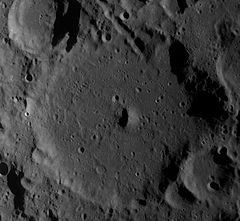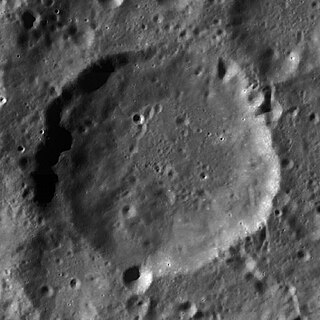 LRO WAC image | |
| Coordinates | 43°54′S119°54′E / 43.9°S 119.9°E Coordinates: 43°54′S119°54′E / 43.9°S 119.9°E |
|---|---|
| Diameter | 104 km |
| Depth | Unknown |
| Colongitude | 242° at sunrise |
| Eponym | Johannes Diderik van der Waals |

Van der Waals is a lunar impact crater on the far side of the Moon. It is a heavily eroded feature with an irregular outer rim. The edge is lowest along the southern side where it is little more than a circular crest along the ground. It is more developed along the northern side, but the rim is notched and rugged. The satellite crater Van der Waals W is attached to the exterior of the northeast, and Van der Waals H intrudes into the rim along the southeast. The interior floor is relatively even and featureless, with only a few tiny craterlets to mark the surface.

Lunar craters are impact craters on Earth's Moon. The Moon's surface has many craters, almost all of which were formed by impacts.

An impact crater is an approximately circular depression in the surface of a planet, moon, or other solid body in the Solar System or elsewhere, formed by the hypervelocity impact of a smaller body. In contrast to volcanic craters, which result from explosion or internal collapse, impact craters typically have raised rims and floors that are lower in elevation than the surrounding terrain. Impact craters range from small, simple, bowl-shaped depressions to large, complex, multi-ringed impact basins. Meteor Crater is a well-known example of a small impact crater on Earth.

Earth's Moon is an astronomical body that orbits the planet and acts as its only permanent natural satellite. It is the fifth-largest satellite in the Solar System, and the largest among planetary satellites relative to the size of the planet that it orbits. The Moon is, after Jupiter's satellite Io, the second-densest satellite in the Solar System among those whose densities are known.
Nearby craters of note include Clark to the north, Carver to the east, and Pikel'ner to the southeast. About two crater diameters to the west-southwest is Lebedev.

Clark is a lunar impact crater that lies in the southern hemisphere of the Moon's far side. It is located midway between the larger walled plain Van der Waals to the south and the similar-sized crater Pizzetti to the north. It is named for American astronomer and telescope maker Alvan Clark and his son Alvan Graham Clark.

Carver is a lunar impact crater that is located on the far side of the Moon, due east of the walled plain Van der Waals. To the northeast is the crater Rosseland, and to the south-southeast lies Kozyrev.

Pikel'ner is an impact crater on the Moon's far side, named for the Russian astronomer Solomon Pikelner. It lies to the southeast of the larger crater Van der Waals, and to the north of the Vallis Planck cleft. Pikel'ner overlies more than half of the satellite crater Pikel'ner Y to the north. Almost contacting the southwestern outer rim of Pikel'ner is a larger concentric crater formation with the smaller crater of the pair, Pikel'ner S, along the northern edge of the pair.



















